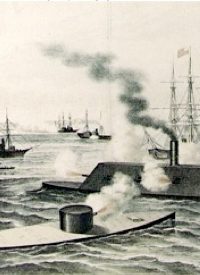
The American Civil War was the bloodiest conflict in our nation’s history, made all the more tragic by the fact that, with more willingness by both sides to negotiate differences, it might have been avoided. It has long raised constitutional questions, as well, with its alteration of the fundamental relationship between the federal and state governments continuing to this day.
Yet, despite these lamentations, that war provided incentive for much American greatness. Surely few episodes exhibit that special genius of our nation more than the naval battle fought between March 8 and March 9, 1862. One hundred and fifty years ago, Americans in their two separate governments simultaneously decided to combine steam power, iron armor, and modern canons to form two ironclad ships that outclassed all other ships in the world.
The C.S.S. Virginia (called by Northerners the Merrimac) was an ingenious design of sloped iron sides with a battery of four guns on either side with another three guns aft and three guns forward. By a twist of fate, the Tredegar Iron Works that armed the Virginia could produce only smooth bore guns, which reduced the velocity and accuracy of fire. This seemed unimportant at the time, because the Confederates anticipated that the Virginia would be facing only wooden ships (which was the case on the first day). Rifled guns would have been able to pierce the armor of the Monitor, and may have sunk the Union ironclad on the second day of the battle. The history of the Civil War pivoted on such small things.
As it was, the U.S. Navy was haggling with an eccentric genius, John Ericsson, who felt cheated out of past payments. Secretary of Navy Gideon Welles had spies who told him about Confederate plans to build an ironclad, and he created a commission known as the Ironclad Board to counter the threat. Ericsson proved indispensable and ultimately he agreed to build a Union ironclad. This vessel, however, was a small ship unlike anything that had ever sailed in any navy. It had almost no freeboard at all and the risk of swamping was serious. The Monitor also had only two guns, 11-inch Dahlgren guns that rotated on a turret allowing the ship, in theory at least, to fire in any direction. Ericsson insisted that the guns have a 15-pound charge instead of the 30-pound charge that the gun could fire. The larger charge could have pierced the steel plate of the Virginia, sinking the Confederate ship when the two met.
On the first day of the battle, the Virginia steamed directly into the heart of the Union flotilla at Hampton Roads, sinking the Cumberland and the Congress, and then attacking the Minnesota before nightfall caused her to return. In one of those personal tragedies that was inevitable in a civil war in which brother fought brother, Frank Buchanan, who commanded C.S.S. Virginia, fought on that first day against Lieutenant Commander McKean Buchanan, who was the commander of the U.S.S. Congress.
The next day the odd-looking Monitor steamed slowly into the fray. Its goal was to protect the Minnesota, which had been grounded, attacked, but not sunk the previous day. Neither ironclad could mortally wound the other. Much of the combat was at very close quarters with shellfire bouncing off, knocking out smokestacks, inflicted injuries to both crews, but not sinking either vessel. Ultimately both ships withdrew from Hampton Roads, assuming victory when in fact the battle was as close to a draw as naval combat can get.
The Confederacy, however, needed more than a draw. The Confederate Navy had viewed the Virginia as a vessel that could not only sink Union frigates but break the naval blockade and menace port cities of the North. This mission was considered the key to victory (which meant perpetuating secession from the Union). A tactical standoff, then, meant a strategic loss for the Confederacy.
Monitor-class vessels were added to the Union Navy throughout the war, and these were useful as coastal blockade ships or as river vessels that could absorb punishment from forts as the Union Navy moved through the water arteries of the South. Monitors were notoriously dangerous in bad seas, and the U.S.S. Monitor sank off the coast of North Carolina in just such weather.
Although it has received less historical attention, the South continued to produce ironclads as well, such as the C.S.S. Richmond and the C.S.S. Teaser (or Virginia No. 2). These vessels were somewhat faster than the Virginia and had some rifled guns, although the industrial superiority of the North ultimately meant that the 40 of such Confederate ironclads, built with only what was on hand and traveling at slow speeds in waters with Union naval presence, could not break the blockade or inflict damages that would produce peace.
The Union built about 60 ironclads, nearly all variations on the “cheese box on a raft” design of the Monitor. Some, like the U.S.S. Dictator, actually had decent speed and could travel in the ocean. Most also had the larger caliber, 15-inch, rifled guns that would have been able to sink the Virginia at Hampton Roads.
It is a testament to American genius that so many innovations in warfare — steam-powered ironclads with rotating turrets, steam-powered ironclads with sloping armor, man-powered operating submarines (C.S.S. Hunley), Gatling guns, repeating rifles, and observation balloons for artillery — came out of that awful war. Along with the inventive genius of Americans it is essential also to note the courage of these countrymen who were killing each other.
The battle between the Monitor and the Virginia may seem “safe” to us today, but this fighting was harrowing. It took the great courage of Americans to fight the Battle of Hampton Roads 150 years ago. How sad that these good and brave Americans were fighting each other.



